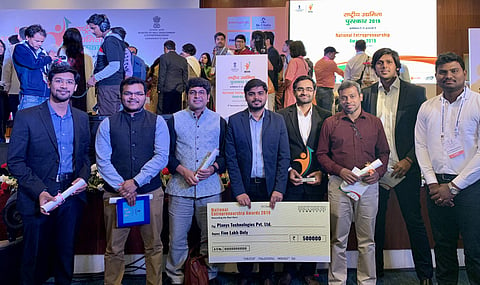

When a group of brilliant minds including three students and two professors from the coveted Indian Institute of Technology Madras, started working on a topic that was close to their hearts — Non-destructive testing (NDT) — four years ago, little did they know that their research would pave way to create a start-up in the field of smart underwater inspection solutions called Planys Technologies. “We were formed in 2015 and were incubated at the IITM Incubation Cell for the first three years after that. We (the student founders) graduated in 2014, and then Planys was moved to an independent facility in 2018, and have been going strong ever since,” says Tanuj Jhunjhunwala, CEO, Planys Technologies, which received the National Entrepreneurship Award in the 'Engineering sector' category from The Ministry of Skill Development & Entrepreneurship (MSDE) recently.
Planys is involved in indigenously manufacturing underwater robots/remotely operated vehicles (ROVs) and it's USP lies in its formulation of complete end-to-end underwater inspection solutions. “Till we entered the market, the underwater inspection industry has been following practices and technologies that are decades old, and are non-digital, expensive and extremely inefficient. For example, most inspections of submerged structures are done by human scuba divers. However, divers have various limitations like lower productivity/limited endurance, limited payload-carrying, depth limitations, mostly data collected is neither robust nor repeatable, thus getting reliable data is a challenge. Overall the operation of diving itself poses a huge safety concern for humans as well. Planys’ technology solutions not only makes the services offered to end-users safer, digital and cost-effective but also help them transition from a time-based inspection protocol to a risk-based inspection protocol thus increasing their efficiency and helping them forecast maintenance and repair,” Tanuj points out.
According to Tanuj, Planys can be called a pioneer in its field because for the first time in India, various dams, railway bridges, power plants, ports etc. are being inspected by Planys’ robots at affordable costs using state-of-the-art technology and overwhelming customer response and feedback. “This is a huge leap for such traditional sectors, that earlier were using primitive technology and could only compute very basic defects using divers. Railways and dams are now at their disposal using Planys’ technology for inspection and maintenance of railway bridge substructure and conditions of emergency/sluice gates in dams,” he adds.
Planys envisions a future where they steer a new course in the maintenance and inspection industry with its disruptive innovations in the field of marine robotics, novel underwater NDT methods and AI-enabled post-inspection analytical digital reporting dashboard. “Our capabilities include underwater HD videography, GPS mapping, ultrasonic thickness inspection, bio-fouling spot cleaning and acoustic surveys. The ROVs (Remotely operated underwater vehicles) we indigenously manufacture are suitable for inspection up to 200m depth, have strong LED illumination and provide a live stream to stable visuals to the control station thus posing no risk to human operators. Unlimited endurance, modularity, compactness, portability and a high degree of manoeuvrability of Planys’ robots make them ideal for inspection and survey applications. These ROVs are highly customisable wherein a host of sensors can be incorporated basis the on-field site conditions and inspection requirement from the asset owner,” explains Tanuj.
